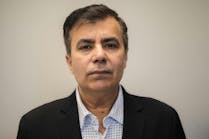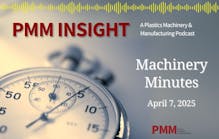By Bruce Geiselman
Vanessa Malena credits her father with instilling in her an interest in how things work, which led her to pursue what — at the time — was an unusual degree for a woman: mechanical engineering. Malena was the only woman in her engineering classes in college.
With a career path that included time with Wittmann Robot & Automation Systems and Arburg, she was approached by a recruiter for Engel Machinery Inc., where she started in 2017 as a key account manager, eventually succeeding Mark Sankovitch as president of Engel North America in October 2022. In this role, she oversees operations including Engel Machinery Inc. (in the United States) and Engel Canada Inc., as well as Engel operations in the Dominican Republic, Puerto Rico and Costa Rica.
Malena discussed her career, the challenges of being a woman in the plastics industry, and her vision for the future of Engel North America with Plastics Machinery & Manufacturing Senior Reporter Bruce Geiselman.
What made you decide to major in mechanical engineering in college? Were there many women in the field then?
No women were in any of my classes at either the technical college or the University of Connecticut. That was one of the reasons why I left UConn. I felt like a fish out of water there.
I went into engineering because my dad was in the Air Force, and then he opened an auto shop. So, I was always around mechanical things. He was very strong on learning. He was an amateur race car driver, and so was my brother. So, I was always involved in mechanical projects. It excited me.
What was your first job out of college?
While in college, I had the choice of internships, and I really wanted to go into the aeronautical field. So, I was going to go to either Pratt & Whitney or Sikorsky because they were in Connecticut, where I was going to school. But there was this smaller company called Wittmann Robot & Automation, and my father said, as a woman engineer, go to the smaller company. You’ll learn more. You won’t be a number.
I took his advice, and that introduced me to the world of plastics. It was a love affair after that, I guess you could say.
When I started an internship with Wittmann, I began copying blueprints for the engineers and doing bills of materials. Then they offered me a job when I graduated, and I became a full-time engineer for them.
How did working at Wittmann open your eyes to plastics?
When I first started there and designing components for other engineers, I didn’t understand the use of the item I was creating because there was no Google to look it up at the time. I saw plastic parts, but I didn’t understand the whole process.
A couple of months in, they took me to Polaroid to see the production, and I finally saw my first molding machine there. After that, I really understood what plastic injection molding machines did and how the robots interacted with them.
Did this Polaroid plant make instant cameras?
That is correct. I always say that I played a small part in the instant camera because I designed some of the automation from Wittmann.
How and why did you join Engel?
I worked in the plastics industry for quite a while, then left for a short time. I wanted to try something different.
A recruiter reached out to me. It happened to be at the right time. They were looking for somebody to come to work for Engel. I admired their company from my past experiences with other companies in the plastics industry. The timing was just perfect. So, I joined Engel [in 2017].
I almost didn’t join because the position was maybe a little bit lower in the organizational structure than I wanted. But I took it to get my foot in the door. It was a key account manager, and within a few months, I was promoted to a different role because they felt I was too advanced for the position. So, I was put into a role above key account managers; I was a business unit manager.
What was your career path at Engel? You moved into the top position in North America quickly.
I sometimes joke about that because somebody said, “How did you move into a position so quickly?”
Mark Sankovitch, my predecessor, and Stefan Engleder, the CEO of Engel Global, gave me the opportunity that probably should have been given to me earlier in my career. They knew that I was beyond some of the positions I was in and that I was capable of handling a lot more. I was always the one that raised my hand and volunteered to take on more. I was successful with selling, and I was successful in technical roles. Sankovitch and Engleder saw that, and it didn’t matter that I was a woman in the plastics industry; they just wanted the right person for the job.
What are the responsibilities of the president of Engel North America?
I have a strong executive vice president who took over the operations side of the business, so that freed me up from the day-to-day details. I’m responsible for the sales organization, our business units, which consist of our strategy and how we handle market situations, the marketing department, and our automation production team. We have automation production in York, Pa., which includes engineers and integrators, and we do entire automation systems. So, all that, plus the building itself falls under my responsibility.
I could look at a P&L statement one hour and then work with builders who are expanding our automation fabrication floor space the next. Or I may be sitting with a customer or reviewing marketing materials for the NPE. It gives me a comprehensive view of the company.
I have several direct reports which have been with the company for quite some time that handle all day-to-day business. I have complete trust in them doing their jobs. Still, I’m able to get involved in things that may need my attention because they become escalated, or someone may need my assistance just because they want another set of eyes, or it could be a customer issue that we need to address.
What do you find most rewarding about your job?
I would have to say the team.
At Engel, it’s a little bit different than a lot of other companies I’ve worked for. It’s truly a team approach to things. No people are standing up to say I want all the credit. Our salespeople work hand in hand with our business units; people work hand in hand with our service team, our automation team, and our marketing team. We work as a family. I can’t describe it as anything else. The people that have been here for 30-40 years, and the newest people, all say the same thing. They feel welcome here and that everyone’s lending a hand to mentor and pass on years of experience and deep-rooted knowledge. It’s the spirit of the company that is truly rewarding for me and the fact that everyone has accepted me as the president and has really supported me in this role.
What major challenges have you encountered?
The biggest challenge is finding technical people, especially service technicians, and training them during COVID times.
A few years ago, our H.R. department and other people in our organization put together an apprentice program. That has helped us with training and placing talent within our service and automation departments. I’ve talked to our competitors at the K Show, and they all have the same problem.
Becoming a service technician for an injection molding company is not something that many people go to school for. There are not many plastics schools in the U.S. Unless you go to a plastics school, it is not a career many people think about.
Being a service technician in the plastics industry is not something that you say you want to do when you grow up.
So, finding talent and training them is a major challenge.
The service techs that have been with us for 25 to 40 years came from farms, they came from factories, and they knew how to take care of equipment. They were MacGyvers, for lack of a better term. No school could teach you that. So, we had to grow our talent from within and have our mentors, our older service technicians, play a big part in training the young men and women in our apprentice program. They are willingly passing on their experience and skill sets to our apprentices. They teach them what to look for in the many facets of the injection molding machine.
What has been your greatest accomplishment?
On a professional level, I’m fair but competitive. My former sales team members still joke with me that I always wanted to be at the top of the list for any sales competition. But truly, my biggest accomplishment is becoming the first female president in the industry [at a major injection molding machine company]. You know, it says a lot for our future. It shows that we’re moving in the right direction and that we’re not just a male-dominated industry anymore.
What have been some of the major milestones Engel has accomplished over the years?
What has Engel reached for milestones? First, we are an industry leader.
We also have developed robust integrated automation.
Another thing is that in North America, we’re one of the few companies with a complete engineering presence, including software, electrical, and mechanical engineers. So, we don’t have to go back to our global headquarters in Austria for everything.
We also have an extensive spare parts hub here. Some of our competitors also have spare parts distribution in North America, but not to the same magnitude. So those are the milestones of Engel.
My milestone while I was in leadership in sales was to develop a team that put together a strategy to grow one of the business sectors by four times the size. And the team did that in four years.
I also believe that Engel does well mentoring team members for career growth. When I was a regional vice president, I had somebody working for me that I mentored, and he became my replacement. And Mark Sankovitch mentored me. He knew that, eventually, I would be in a leadership role. That’s something that Engel feels strongly about — growing from within.
Did your career path always follow plastics or did you work in any other industries?
I was with Wittmann for almost 13 years, and then I left and went to Arburg for seven.
The simple reason was that I had a child, my territory at Wittmann was down south, and I was on the road all the time. Arburg had a territory that was in the Northeast, and that is where I lived. It made it much better for my family life. Plus, it was good to learn something new. I worked at Arburg for seven years, and in the end, I felt like I couldn’t go any further in the company.
I decided to leave, and I left the plastics industry. I went to work for a Danaher/Fortive company — they split while I was there — and it was called Gems Sensors. They designed and manufactured sensors — some fluidic sensing and some sensors for oil pressure gauges and so forth. I enjoyed the company. It was a large publicly traded company and, in fact, the first publicly traded company that I worked for. I got many opportunities to do some rotations and learn about other departments. I learned about lean manufacturing and Kaizen events. I did rotations in production and marketing. It gave me a well-rounded experience in business and added to what I had already learned at Wittmann and Arburg. But in the end, I missed the plastics industry.
That’s when Engel called, and I decided to come here. It was the greatest decision in my life.
What are the trends that you’re seeing in the plastics industry, particularly in North America?
I’ve seen an uptick in interest in circular economy and recycling. It was, at the last K Show [K 2019], maybe a little too soon for the U.S. But now I see more and more of the questions asked to Engel of what we could supply for equipment that will help them with recycled material and closing that circle to become better stewards, especially for plastics.
Another thing is digital products, the wave of the future. Many European companies pushed a narrative that was a little bit too aggressive for the U.S. They didn’t know what to do with all the data. Engel’s approach to digitalization is to make it a lot more intuitive and user-friendly. This enables companies with no staffing to work with digital solutions to use these tools to improve productivity and quality.
The plastics industry has been suffering from some poor public perception. What do you think the industry needs to do to improve its image?
That’s a tough one. We need people to understand that plastic is vital in our everyday lives.
We saw this during the pandemic, we needed plastics. Plastics were critical to our survival, whether it be the testing equipment used or how vaccines were administered.
People must also understand that aluminum and glass products are in our oceans. You just don’t see them because they don’t float. If we did a scan of the bottom of the oceans, you’d see aluminum and glass in our waters threatening aquatic life just as much as plastic.
We need to make it easier for people around the world to recycle and make it more cost-effective. Right now, many customers complain that recycled material costs more than virgin material. So, why would they bother? Or customers have said that it requires more energy to process recycled material. That’s why Engel has made significant advancements in processing plastic flake. This removes the pelletization step and, therefore, the energy required during that process. Engel has also ensured the quality of the parts manufactured using the flake material.
With that technology, you’re talking about directly reusing the material without pelletizing it first?
Yes, we showed the process at the K Show this year. It’s a two-stage technology where we made quarter pallets. Once the pallet part was formed, it was then ground into flakes and put back into the injection molding machine without adding any virgin material. It’s getting the material down to a melt and then using a second injection unit to precisely inject the material into the machine and doing the degassing and filtration right in line so that you are not doing that downstream but right at the press.
How has the injection molding industry changed over the past 28 years?
When I first started designing automation, I designed on a drafting board, and had to make blueprints. When I made a mistake, I couldn’t just make a quick change like our engineers can do today.
On my first business trips, there was no cell phone, computer or GPS. A lot has changed. I didn’t even have a computer in my home.
The equipment followed along. When I first started at Wittmann Robot, the controller was very simple. We thought it was so advanced at the time. But now, you see what can be done, and how Engel robots interact with other equipment and our machines, how intuitive they are.
Another significant advancement is in the machine controller itself. They can alert people when a motor is going bad or if the oil quality in a machine may have debris or water in it. It’ll let you know that something is going wrong with the machine and that you need maintenance to check on it. The technology has gotten so smart.
What have been the most significant changes or improvements to processing equipment that you’ve witnessed or been a part of developing?
Smart technology is helping people. We have technology that will take your mold drawing and mold flow data and help you pick a machine and the right options for that machine. When you do that, it will also start looking at your process, so somebody doesn’t have to start from scratch with doing a process setup.
When molding machines were first introduced, it was dials and a feel. Process people had a feel for what the parts were going to be. They just judged — let me put a little more pressure here, take a little more pressure off here, change this timer — it was a lot different. Now, everything is more intuitive, and you can plan much better.
What is your take on Industry 4.0 in the plastics industry?
It’s crucial. There is such a lack of skilled workers. As the equipment gets smarter and smarter, we gain so much knowledge from it. It will help our companies understand the performance of the machines, variances, and maintenance concerns.
They may need to change their staffing, especially in their I.T. department. The biggest hurdle that most companies have is their firewalls and getting information out and the exchange of information, and people that deal with data. But it is critical for our future. The workforce is limited, and it can add costs to production. But, if we don’t want to lose business to other countries, we have to embrace Industry 4.0 here in North America.
What do you see as the next major development in injection molding?
An increase in automation, and not just beside the press, but also in material coming into the process, to goods being loaded onto trucks.
Autonomous Artificial Intelligence is another significant development that allows the machine to run on its own. That’s a big draw for people — to say, I could have “lights out” production without anyone onsite.
Technology will keep advancing with more automation and less human interaction.
Energy is going to become an issue. We already see it happening in Europe. I don’t think the U.S. has felt the same kind of energy crisis as Europe is experiencing, but we probably will at some point and some level. Does that mean we have to go with fully electric machines? Maybe not. Our hydraulic machines are also improving year over year concerning energy efficiency.
Other major developments will involve less energy, more efficiency, faster cycle times, more automation, and less human interaction.
Outside of work, what are your hobbies?
I like cooking, baking, and spending time with my family in the winter. I have a husband and a 20-year-old son who’s going to school for mechanical engineering.
In the summer, we have a boat, and we like to go clamming and fishing and swimming in the ocean.
I also like to read. I just downloaded a book that Kleta [Childs, senior marketing manager at Engel] suggested to me: “Taste [My Life through Food],” by Stanley Tucci. And I just finished the book “Build to Last [: Successful Habits of Visionary Companies].” I usually like to have one or two books going at once, whether they’re on audio or paper.
You mentioned that your son is studying mechanical engineering. Do you think he’s going to follow his mom into the plastics industry and work at Engel someday?
He wants to be a service technician for Engel.
He is a hands-on type of person, and he tries to tell me that I could save some money and that he could just quit school and become a service tech now. He also has a passion for automation. Many years ago, he was at a plastics show with my husband and me, and he saw the equipment and fell in love. He learned that Legos were made on injection molding machines. He was a Lego kid.
He’ll probably follow in mom’s footsteps. He won’t want to do anything sales-related or business-related, though. He’s hands-on, for sure.
Is there anything that you’d like to discuss that perhaps I didn’t think to ask you?
One question you didn’t ask is about the greatest challenge I faced in my business career. It’s important for me to address that.
As a woman, I hadn’t been considered for many roles. But I want to note that several leaders throughout my career saw my value.
The first was Dave Preusse [president of Wittmann Battenfeld Inc.]. He promoted me within the company, and he saw my value. Then at Engel, there were Mark Sankovitch and Stefan Engleder. I just wanted to mention that.
You’re a long way from retirement, but have you given any thought of how you would like to be remembered and the legacy you would like to leave?
I have because you never know when you’ll need to retire someday, and I don’t want to retire when I’m too old, either.
I would say fair and hardworking when it comes to the industry and my team. Fair, hardworking, competitive, but honest. I’ve always been honest with my competitors. I don’t play dirty, but I like a good competitive game.
The other thing I am is empathetic, not just to customers but also to employees. There’s life beyond a molding machine. A customer feels that there isn’t, but an employee feels that there is, so you have to balance those two things.
Mark Sankovitch is still in the business, but he left me with a thriving company. We have a great team, and I want to work hard to leave it better than he left it for me. And I also want to grow a team — my leadership team that I trust so much — I want to grow them so that they could someday take over.
Just the facts
Who is she: Vanessa Malena, president of Engel North America
Education: Associate degree, mechanical engineering, Naugatuck Valley Technical College, Waterbury, Conn., 1994. Also attended the University of Connecticut.
Years in the plastics industry: 28
Age: 50
Company founded: Engel Austria, GmbH, 1945; Engel established its first North America location in Canada in 1974; Engel built its current North American headquarters in York, Pa., 1989.
Employees: 7,000 globally; 267 in U.S. and Canada.
Bruce Geiselman | Senior Staff Reporter
Senior Staff Reporter Bruce Geiselman covers extrusion, blow molding, additive manufacturing, automation and end markets including automotive and packaging. He also writes features, including In Other Words and Problem Solved, for Plastics Machinery & Manufacturing, Plastics Recycling and The Journal of Blow Molding. He has extensive experience in daily and magazine journalism.






